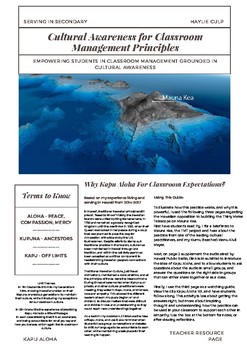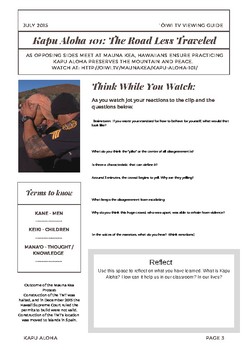Kapu Aloha - Hawaiian Cultural Connections for Grounded Classroom Management
Serving in Secondary
52 Followers
Grade Levels
7th - 10th
Resource Type
Standards
CCSSRI.7.4
CCSSRI.7.5
CCSSRI.7.6
CCSSRI.7.7
CCSSRI.8.2
Formats Included
- PDF
Pages
4 pages
Serving in Secondary
52 Followers
Description
This product includes a three-part introduction to culturally informed classroom management.
The first page is a teacher resource guide which describes relevant background information on Kapu Aloha and why it should be used to shape classroom culture. Using this practice has been an essential part of my classroom foundations to create a learning community that empathizes and listens to understand rather than listens to respond. It is has been a HUGE benefit to our speaking and listening skills with my 7th & 8th Grade students.
Unit Themes:
In 7th Grade I tie this into my Generations intro, showing Hawaiians relied on their Kapuna or previous generations to maintain their culture while introducing my exceptions for our classroom culture.
In 8th Grade I tie the experience of practicing Kapu Aloha to a Rite of Passage.
In each case stressing that it is an awareness, and being accountable for what you say and how you behave, which again ties to classroom culture.
To illustrate how this practice works, and why it is powerful, I use each of the 3 pages regarding the Hawaiian opposition to building the Thirty Meter Telescope on Mauna Kea.
First have student's read Pg. 1 for a brief intro to Mauna Kea, the TMT project and hear about the practice from one of the leading cultural practitioners, and my Kumu (teacher) Manu Aluli Meyer.
Next, on page 2 supplement the audio aired by Hawaii Public Radio, (link is in subtitle) to introduce the idea of Kapu Aloha, and to allow students to ask questions about the audio in small groups, and answer the questions on the right side in groups that can either share together or as a class.
Finally, I use the third page as a watching guide. View the clip Kapu Aloha 101, and have students follow along. This activity is less about getting the answers right, but more about inspiring thought and understanding how the practice can be used in your classroom to support each other in building empathy. Use the box at the bottom for notes, or after viewing reflections.
The first page is a teacher resource guide which describes relevant background information on Kapu Aloha and why it should be used to shape classroom culture. Using this practice has been an essential part of my classroom foundations to create a learning community that empathizes and listens to understand rather than listens to respond. It is has been a HUGE benefit to our speaking and listening skills with my 7th & 8th Grade students.
Unit Themes:
In 7th Grade I tie this into my Generations intro, showing Hawaiians relied on their Kapuna or previous generations to maintain their culture while introducing my exceptions for our classroom culture.
In 8th Grade I tie the experience of practicing Kapu Aloha to a Rite of Passage.
In each case stressing that it is an awareness, and being accountable for what you say and how you behave, which again ties to classroom culture.
To illustrate how this practice works, and why it is powerful, I use each of the 3 pages regarding the Hawaiian opposition to building the Thirty Meter Telescope on Mauna Kea.
First have student's read Pg. 1 for a brief intro to Mauna Kea, the TMT project and hear about the practice from one of the leading cultural practitioners, and my Kumu (teacher) Manu Aluli Meyer.
Next, on page 2 supplement the audio aired by Hawaii Public Radio, (link is in subtitle) to introduce the idea of Kapu Aloha, and to allow students to ask questions about the audio in small groups, and answer the questions on the right side in groups that can either share together or as a class.
Finally, I use the third page as a watching guide. View the clip Kapu Aloha 101, and have students follow along. This activity is less about getting the answers right, but more about inspiring thought and understanding how the practice can be used in your classroom to support each other in building empathy. Use the box at the bottom for notes, or after viewing reflections.
Total Pages
4 pages
Answer Key
N/A
Teaching Duration
90 minutes
Last updated Apr 22nd, 2018
Report this resource to TPT
Reported resources will be reviewed by our team. Report this resource to let us know if this resource violates TPT’s content guidelines.
Standards
to see state-specific standards (only available in the US).
CCSSRI.7.4
Determine the meaning of words and phrases as they are used in a text, including figurative, connotative, and technical meanings; analyze the impact of a specific word choice on meaning and tone.
CCSSRI.7.5
Analyze the structure an author uses to organize a text, including how the major sections contribute to the whole and to the development of the ideas.
CCSSRI.7.6
Determine an author’s point of view or purpose in a text and analyze how the author distinguishes his or her position from that of others.
CCSSRI.7.7
Compare and contrast a text to an audio, video, or multimedia version of the text, analyzing each medium’s portrayal of the subject (e.g., how the delivery of a speech affects the impact of the words).
CCSSRI.8.2
Determine a central idea of a text and analyze its development over the course of the text, including its relationship to supporting ideas; provide an objective summary of the text.





